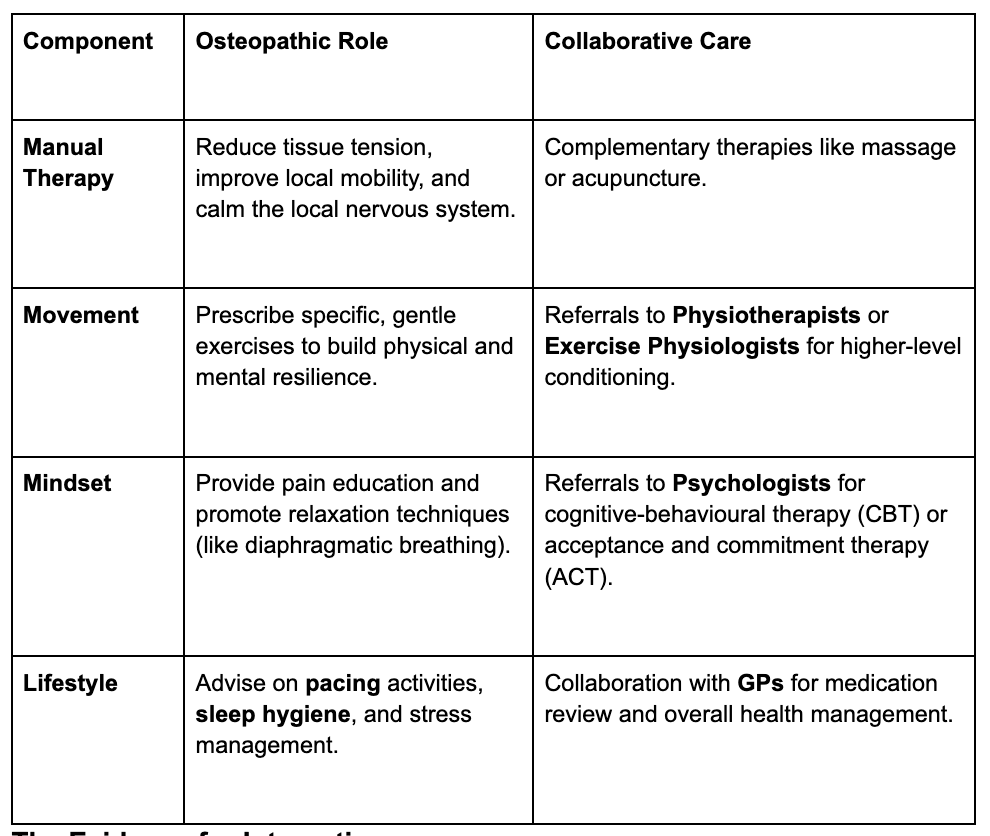How Osteopathy Helps Manage Chronic Pain: A Whole-System Approach
If you’ve been living with chronic pain for months or even years, you know the cycle of seeking relief, trying new treatments, and often feeling stuck. It’s a frustrating journey that can leave you feeling powerless.
At Woodend Osteo, we understand that when pain persists, the solution isn't about finding a single "fix."
Recent research has shown that it requires a sophisticated approach that moves beyond temporary symptom relief to address the whole person: calming an over-protective nervous system, optimising movement, and restoring balance.
We aim to partner with you, helping you understand your body’s signals, move more confidently, and ultimately regain control of your day-to-day life.
The Osteopathic Philosophy: Connecting the Dots
Osteopathy is an evidence based form of manual therapy that treats the body as an interconnected unit. We don’t just focus on the site of your pain; we investigate how the musculoskeletal system and the nervous system interact to create your pain experience.
What an Osteopathic Assessment Involves:
Your osteopath will conduct a detailed assessment to look for contributing factors beyond the obvious:
Movement Analysis: We observe how you stand, sit, and move to identify patterns of learnt pain avoidance that create strain and compensation and that might be loading sensitised areas.
Tissue Health: We gently palpate joints, muscles, and fascia to locate areas of restriction, tension, or hypersensitivity.
Biopsychosocial Context: We discuss lifestyle factors like sleep quality, stress levels, work demands, and your beliefs about your pain, as these significantly influence chronic pain.
Treatment then uses hands-on techniques tailored specifically to you:
Soft Tissue Techniques: massage, stretching, and specific pressure to reduce muscle guarding and local inflammation.
Joint Mobilisation & Articulation: to restore motion to stiff or restricted joints, improving joint dynamics and reducing protective tension.
Mind-Body Techniques: Breathing retraining and postural advice to help down-regulate the nervous system directly on the treatment table.
The Two Key Ways Osteopathy Helps Chronic Pain
When pain is chronic, the therapeutic goals shift from simple tissue repair to systemic change—making the whole body less reactive and more resilient.
1. Desensitising the Nervous System
As explored in our previous blog, chronic pain involves a sensitisation of the central nervous system. The alarm volume is turned up high. Osteopathic treatment helps to turn that volume down:
Tactile Input: Gentle, rhythmic, and consistent manual techniques send non-threatening, positive signals to the brain. This "safe" sensory input directly competes with the brain's internal "danger" message, helping to calm the protective reflex and reduce muscle guarding.
Improved Autonomic Balance: Many techniques, particularly those targeting the thoracic and cervical spine, can help shift the body out of a sympathetic "fight or flight" state and into a parasympathetic "rest and digest" state—a crucial step for reducing overall pain sensitivity.
2. Restoring Functional Movement & Confidence
A key consequence of chronic pain is fear-avoidance (kinesiophobia), where people stop moving because they fear re-injury or increased pain. This leads to stiffness, weakness, and prolongs the experience of pain.
Reducing Mechanical Load: By improving mobility in areas distant from the pain site (e.g., treating a stiff hip to relieve low back strain), we offload the irritated tissues. This reduces the mechanical input of pain signals.
Graded Exposure and Movement Education: We don't just treat you; we teach you. Osteopaths prescribe tailored, gentle exercises designed to challenge your body safely. This process of gradually introducing movement helps the brain "re-map" the body part, building physical strength and mental confidence that the body is strong, not fragile.
Addressing Pain Catastrophising: By providing a clear, science-backed explanation of why the body hurts, we help shift the focus from fear and helplessness toward understanding and capability.
Beyond the Treatment Table: A Multidisciplinary Plan
While hands-on treatment is vital, lasting change in chronic pain management relies on active participation. Osteopathy is often the starting point, but we believe in a holistic, integrated care plan.
The Evidence for Integration
Current best evidence for chronic musculoskeletal pain strongly supports a combination of manual therapy, therapeutic exercise, and pain education. Osteopathy uniquely packages these elements—treating the body, educating the mind, and providing the tools needed for sustainable recovery.
Ready to shift your focus from pain management to empowerment? Book an initial assessment with Woodend Osteo to start building your personalised plan to reclaim your quality of life.




